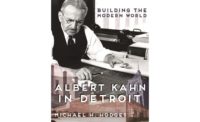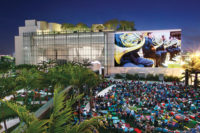This well-illustrated compendium is a detailed history—fascinating and, to some, unfamiliar—that makes the case that Modernist architecture and design was developed in Michigan, not imported from Europe between 1900 and 1970. As California critic Alan Hess says in the foreword, “Modernism grew directly from the state’s indigenous industries and the population they served.”
The case is built by the nearly 30 essays in the book, which grew out of a symposium at the Grand Rapids Art Museum in 2014. The editors—Amy L. Arnold, preservation planner for the State Historic Preservation Office, and architect Brian D. Conway, Michigan State’s Preservation Officer— had organized the three-day conference.
Much of the story, of course, has to do with the auto industry.
Prussian-born architect Albert Kahn came to America with his family in 1881, started working in a Detroit architecture firm as a teenager, and opened his own firm in 1895. His five younger brothers, obsessed with engineering, all worked with him; one of them, Julius, invented a “trussed-bar” system of steel-reinforced concrete construction that revolutionized modern factory design.
In 1905, when the Packard Motor Car Company hired Albert Kahn to build a new factory, he integrated these new systems. By using a steel-reinforced concrete structural frame, instead of walls of load-bearing masonry supporting wood floors, he could install huge windows, allowing natural light to flood the factory floors. He placed skylights in the concrete roofs and introduced industrial steel sash windows to America (they originated in England).
Henry Ford quickly adopted Kahn’s systems for the Highland Park Ford Plant (1908) and the Ford River Rouge Complex (1917), where each piece of the manufacturing process was housed in a separate building. As Arnold and Conway explain, the factories he designed for Henry Ford “became an inspiration for architects around the world who were looking for a ‘modern’ approach to design; most notably European architects Le Corbusier, Walter Gropius, and Ludwig Mies van der Rohe.”
At the same time, in 1906, the University of Michigan hired architect Emil Lorch to head its new architecture program, one of the first modern-oriented ones in America. Lorch, who followed the ideas of the Prairie school and eschewed traditional Beaux Arts training, invited Finnish architect Eliel Saarinen to be a visiting professor in 1923. There Saarinen met newspaper publisher George Booth (the father of a student), who enlisted Saarinen to help run the new Cranbrook Academy, which came to be known as architecture’s “cradle of Modernism.” Saarinen not only designed the campus but also created a program that incorporated philosophies of both the Arts and Crafts movement and the Bauhaus. The school attracted such students and teachers as Alvar and Aino Aalto, Harry Bertoia, Niels Diffrient, Charles and Ray Eames, Florence Knoll, Bill Moss, Harry Weese, and, of course, Eliel’s son Eero Saarinen—designers who would shape and define modern design in midcentury America.
The furniture companies in Grand Rapids took note. After Herman Miller lured George Nelson to its company in 1947, he brought in the Eameses, Alex Girard, and Isamu Noguchi. And Florence Knoll commissioned Eero Saarinen, Bertoia, and Mies to contribute pieces. The list goes on. The book demonstrates how Michigan’s industries, educational institutions, and businesses employed the most innovative architects and designers of the day, who in turn lured the best and brightest to come and work with them. In this way, Modernism and Michigan were inextricably tied





Post a comment to this article
Report Abusive Comment